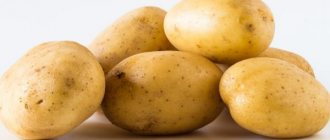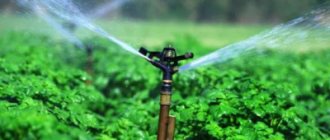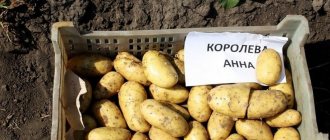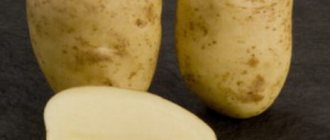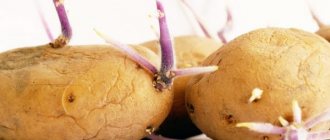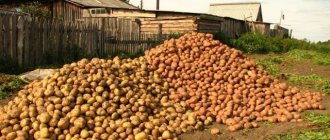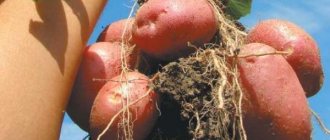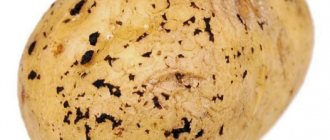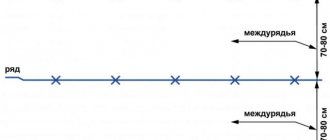Description of the Jura potato variety
The height of the bush reaches 40-60 cm, the shoots are powerful, with large wavy leaf plates. Flowers in the form of large whitish corollas appear a month after the tubers germinate. The process lasts for 7-10 days, after which green berries form on the tops.
Isle of Jura potatoes are frost-resistant varieties, so they bear fruit successfully even at low temperatures. The culture is resistant to high air humidity and wind.
The hot climate negatively affects the yield of the Jura variety, so its cultivation in arid regions requires additional care. It is recommended to cultivate the vegetable in the Central zone.
Important! The tubers of the variety are resistant to late blight and potato cancer, and golden nematode. The crop requires mandatory treatment against the Colorado potato beetle.
Agricultural technology
Landing
Potato Alena
The Jura variety can be easily grown by a novice farmer. It does not require care and is easy to plant. However, the Isle of Jura has a number of peculiarities in agricultural technology.
Potatoes are planted in open ground. The area should be sunny; lowlands are not suitable. The land needs to be prepared in the fall. The best place for this variety is an area where perennial grasses, winter crops, legumes, and flax grew. The soil is dug well, plant roots are removed, and organic matter is added. The Jura variety does not like sour, heavy soil. Immediately before planting, the place where the potatoes will grow is dug up again. Peat and sand are added. Planting takes place in May.
Note! It is recommended to plant potatoes after the first leaves appear on the birch tree.
In April, planting material is placed in a bright place, where it is about +12 degrees. Such conditions will help the potatoes to germinate faster. Large Jura potatoes can be cut into small pieces, which are planted as independent tubers. Before planting, the material is treated with manganese or garlic infusion. It is believed that this procedure will disinfect the tubers from pests and also act as a growth stimulator. You can buy special medications in stores.
Planting a crop
The variety is planted using a shovel or equipment, for example, a walk-behind tractor, a tractor. The bushes of the Isle of Jura, although spreading, are not tall. Therefore, the holes are placed at a distance of 40-50 cm. Rows are made every 50-60 cm.
Methods of planting varieties: smooth, ridge. Ridge cultivation is carried out when the soil is heavier. The ridges are made from north to south. Thus, the plantings will be exposed to the sun during the day.
In order for Isle of Jura potatoes to develop normally, the tubers are planted to a depth of 8-10 cm. Ash, onion peels, and complex fertilizer are added to the holes along with the potatoes.
Care
Caring for the crop is simple. Operations include: weeding, loosening, watering, hilling, treatment against pests and as a disease prevention. Jura is a type of potato that does not require additional fertilizing during the growing season if planted in fertilized soil.
Weeding can be combined with loosening the soil. Weeds are removed throughout the summer.
It is best to do this as soon as it has rained. The earth is loosened with a rake and weeds are removed. After rain, this procedure will help avoid the formation of a hard earthen crust.
Watering is rare. If the weather is hot, the potatoes need to be watered once a week. One bucket of water is consumed per bush.
During the season you need to carry out several hillings. The procedure will help saturate the soil with oxygen and remove weeds. The summer resident should carry out the first hilling after the seedlings have stretched to 10-15 cm. The second time this is done after 3-4 weeks. The third time - in a month.
Hilling up potatoes
Important! A good preventative against the Colorado potato beetle on potatoes is an ash solution; the ash can be applied to the tops. If the beetle has already appeared, then various chemicals are sold in stores. It will be effective to collect larvae and the Colorado potato beetle itself.
An infusion of garlic will help fight leaf blight, to which Jura potatoes are susceptible. Every 10 days the bushes are sprayed with Bordeaux mixture, one percent is suitable.
Characteristics of the Jura potato variety
The variety has an early growing season, so the tubers should be dug up 70-80 days after planting the seed. Potatoes are considered conditionally ripe after 2 months.
Productivity
From 6 to 10 potatoes ripen in one bush. From 1 hectare it is possible to collect 248-338 centners of tubers. The maximum crop yield is 415 c/ha.
Characteristics of Jura potatoes:
- the tubers are oblong-oval, smooth, with small eyes and elastic yellow skin;
- the flesh of the fruit is creamy, without spotting and has a weak aroma;
- oily, potato taste;
- starch content 12-16%;
- the weight of one fruit varies between 110-180 g.
The Jura variety is characterized by a high content of carotene and vitamins: A, E, C B. The tubers contain many microelements: potassium, phosphorus, iron and others.
Potatoes can be used in cooking: baked, fried, added to various dishes. After cleaning it does not darken for a long time. The tubers are not overcooked.
Potatoes can be used in medicine to treat coughs and colds. In cosmetology, the culture is known as a remedy for age spots and wrinkles.
How to store Jura potatoes
The tubers have high commercial quality, reaching 90%. According to reviews, Isle of Jura potatoes store well, which allows us to characterize their keeping quality as above average.
Up to 95% of the harvest successfully overwinters in an equipped cellar, preserving its appearance and taste until spring.
Important! The variety is mid-early, so it is preferable to use it for food. It is recommended to organize storage in the cellar only for seed tubers.
Advantages and disadvantages
The crop is known as a high-yielding variety that is resistant to unfavorable conditions. Isle of Jura potatoes, when grown in the Central region, exhibit the best qualities:
- rapid formation and ripening of tubers;
- good keeping quality and marketability of the crop;
- versatility of use;
- resistance to golden nematode, cancer.
The disadvantages of the variety include its inability to withstand drought, which negatively affects the yield and vital activity of the plant. Jura potatoes require regular treatment against the Colorado potato beetle.
The main advantages and disadvantages of the variety
Isle of Jura potatoes have proven to be high-yielding and hardy in unfavorable conditions. The tubers develop quickly, acquire the correct shape and gain weight. Potatoes belong to the mid-early varieties - they begin to dig 65-80 days after the first sunrises appear.
Gardeners highlight the following advantages of this variety:
- excellent keeping quality;
- versatility of use;
- pleasant and rich taste;
- unpretentiousness in care and weather conditions;
- resistance to many diseases, in particular golden nematode, late blight, cancer;
- early harvest;
- presentation of tubers.
Jura has no serious drawbacks. There is a relative disadvantage - the inability to develop normally in too dry summers.
Landing rules
The yield of the crop depends on compliance with the rules of agricultural technology of the Jura potato variety. The best predecessors are representatives of legumes and melons, cabbage and carrots.
Recommended timing
Planting in open ground is carried out in May after the ground has warmed up, the risk of night frosts will decrease.
Planting too early will cause the flowers to freeze, which will reduce the yield of Jura potatoes or lead to the death of the plant.
Important! It is recommended to do sowing work after the birch leaves bloom.
Soil preparation
For successful cultivation of the variety, it is necessary to prepare a spacious, well-lit area located on a hill. The best option is a bed fenced from the winds with groundwater lying at a depth of at least 2 m.
Yields are reduced if Jura potatoes are planted in acidic, infertile soil. The soil must be moisture-permeable, with neutral acidity.
Enrichment of the soil before planting Jura potatoes is carried out in the fall: the ground is plowed, 6-8 kg of manure and 30 superphosphate per 1 square meter are added to the soil. m. During the planting process, it is recommended to distribute 130-180 g of wood ash along the bottom of the hole. It not only serves as a disinfectant, but also repels pests.
How to plant correctly
It is recommended to prepare Jura potato tubers for planting from April: sort through the seeds, remove rotten vegetables damaged by rodents. Good seed must be placed in a well-lit room where the temperature does not fall below + 12 °C. This will allow the tubers to germinate.
Important! For sowing the Jura variety, it is recommended to select medium-sized potatoes; large fruits can be cut into several parts.
To stimulate growth, you can use the drugs Zircon or Mival. Manganese solution has a disinfecting effect, so before planting, Jura potato tubers are sprayed with the substance. To obtain it, 1 g of manganese is diluted in 10 liters of water.
It is also possible to use copper sulfate as a disinfectant: 10 g of the substance per 30 liters of water. To obtain the solution, wooden or glass containers are required. Metal containers cannot be used.
Basic principles of planting:
- in the plowed prepared soil, ridges are formed in which holes are dug;
- planting pattern is 50*60 cm;
- place the tubers in the hole so that the sprouts are directed upward;
- sprinkle the seed with soil;
- moisten the soil abundantly.
If sandy loam or loamy soil predominates in the garden, then the depth of the planting hole should be 8-10 cm. For heavy clay soils, it is advisable to place Jura potatoes to a depth of 5-6 cm.
To retain moisture in the soil, immediately after planting, it is recommended to cover the beds with a layer of sawdust or straw. Mulch will prevent weed growth.
Advice from experienced gardeners and reviews about the Isle of Jura variety
Experienced gardeners recommend promptly removing weeds, hilling up plants, applying fertilizer, and getting rid of the Colorado potato beetle. Pay special attention to bushes during the flowering period. It is at this stage that potatoes need feeding and watering.
Reviews about the Jura variety are only positive.
Alexey, Yasnogorsk: “I decided to try to plant Isle of Jura potatoes. Two weeks ago I dug up large and fleshy tubers. The overall impression of the development of the bushes and the taste of the cooked potatoes is positive. I was pleased with the variety’s resistance to adverse weather conditions and diseases.”
Natalya, Dyatkovo: “I have been growing Jura potatoes for more than two years. I am pleased with the stable yield. One bush produces 1.5 kg of large, neat potatoes. I was able to get this result after adding wood ash to the holes. I recommend everyone to try growing this variety.”
Features of cultivation
Agrotechnical features of caring for Jura potatoes include watering, loosening the soil, removing weeds and hilling.
Watering schedule
Jura potatoes are a moisture-loving variety, so it is recommended not to neglect the watering procedure. If there is insufficient precipitation, the following schedule should be followed:
- 2.5-3.5 liters of water are poured under each bush when the height of the tops reaches 13-15 cm;
- after the flowers bloom, 6-7 liters of water are distributed to each plant;
- During the tuberization period, Jura potatoes require 10-12 liters of water.
It is not recommended to use underground sources for irrigation: sudden temperature changes negatively affect the plant’s immunity. The water should be warm, pre-settled.
Loosening, weeding, hilling
To increase productivity throughout the growing season, it is necessary to regularly remove weeds that interfere with the normal growth of the bush.
You can combine weeding with the loosening procedure: dig up the soil to a depth of 5 cm with a special garden tool (hoe, ketmen) to provide oxygen access to the potato roots.
Hilling of the Jura variety is required 3 times per season. The first procedure is carried out when the bush reaches a height of 10-15 cm. Hilling up again must be carried out after 3-4 weeks, and then after another month. The procedure is aimed at saturating the soil with useful substances and limiting the growth of weeds.
Do I need to feed
Fertilizers are applied at the roots after the first watering. It is recommended to use complex formulations as fertilizers: Kemira, Bulba or AVA.
You can prepare a nutrient mixture for treating leaves. To do this, dissolve the following substances in 10 liters of water:
- urea (from 90 to 110 g);
- boric acid (5 g);
- potassium monophosphate (150 g).
Processing of leaf plates is carried out in the morning or evening so as not to burn the plant.
Repeated feeding by spraying is carried out after 3 weeks, but the solution is prepared more concentrated: all substances are dissolved in 5 liters of water.
Care
Caring for potatoes of this variety comes down to the following steps:
- weeding;
- loosening;
- hilling;
- watering.
Weeding and loosening
Weeding and loosening can be done simultaneously using a rake. It is advisable to carry out these important manipulations for the culture immediately after precipitation falls. In this case, weeds will be removed easily, since the soil is soft and pliable.
Important! Weeds must be removed throughout the summer.
Hilling
Hilling is carried out at least three times per season. First, this important procedure is carried out when the sprouts have reached a height of 15 cm. Next time it is necessary to hill up the potato bushes after a month. The last time this is done is after about 5 weeks or as needed.
Pests and diseases
Jura potatoes are not susceptible to the development of scab and blackleg. Under unfavorable conditions, it can be affected by late blight, which requires preventive measures. To do this, potatoes are treated with fungicides Oxyx or Ridomil.
To protect the variety from pests, cutworms and wireworms, it is necessary not to neglect weeding and loosening. Insecticide treatment is carried out when attacked by aphids and whiteflies. The photo of the Jura potato variety shows the Colorado potato beetle, one of the common pests:
To destroy it, complex measures are used: the bush is treated with Tornado, Tabu, Aktara.
Diseases and pests
This variety is resistant to many diseases, but not all. It can also suffer from common parasites.
Late blight
Late blight is a dangerous fungal disease that can completely destroy a crop. If dark purple or black spots are found on the leaves of potato tops, you should sound the alarm, as this is late blight. Having spread throughout the entire bush and root system of the plant, the disease affects young tubers, turning them into an unusable, foul-smelling substance.
As practice shows, traditional methods are ineffective in the fight against this disease. It is better to immediately start using special means aimed at combating this fungal disease. They are divided into:
- protective (applied to the tops before pathogenic spores spread);
- curative (drugs that can infect late blight spores);
- stopping the activity of the pathogen (the fungus stops reproducing and dies).
Harvesting and storage
It is recommended to collect tubers no earlier than 65 days after sowing. To do this, dig up the bush, remove the potatoes from the hole and put them in a bucket.
The ripeness of the crop is determined by the peel: it must be strong. The collected tubers must be thoroughly dried and transported to a dark room (cellar or basement). Before moving to storage, potatoes should be sorted. Large potatoes are used for food, smaller ones are stored as seed.
It is recommended to store the harvest in wooden pallets, making sure that no moisture gets on it.
Pros and cons of the Jura variety
Potatoes have proven to be high-yielding and hardy in conditions of cool summers and frequent rainfall, characteristic of the areas of the Central region, where the variety is recommended for cultivation. Tubers quickly form and gain weight. The variety begins to be dug 65-80 days after emergence. Over the years of cultivation, gardeners have compiled a list of advantages of Isle of Jura potatoes:
- early production;
- good yield in the group of mid-early varieties;
- high marketability of tubers;
- excellent keeping quality;
- versatility;
- pleasant taste of dishes;
- unpretentiousness to the weather conditions of central Russia;
- resistance to a number of diseases.
If the disadvantages include the specially selected by breeders undemandingness to rather harsh weather conditions, then the disadvantage of this variety is that it is not adapted to droughts. The Isle of Jura is the brainchild of Scottish agronomists, where areas are more likely to suffer from plenty of rain, but not from dry periods.
Planting and growing potatoes
Romano potatoes are not picky about growing conditions, but some minimum recommendations for choosing a location for plants must be followed.
Did you know? Potatoes were introduced into Europe around 1580, but were long considered unsuitable for food.
This will help get the maximum yield from the bushes and prevent problems from occurring.
- be well lit - in the shade the plants will grow much worse and the tubers in the nest will be small;
- have loose and nutritious soil - in heavy soil, planting material germinates worse, and a lack of fertilizer affects the quality and volume of the harvest;
- do not contain groundwater lying close to the surface of the earth - bushes react poorly to waterlogged soil. If potatoes are planted in an area with high groundwater levels, then planting should be done on ridges;
- to reduce the risk of diseases, it is not recommended to plant Romano potatoes in areas where tomatoes, peppers or eggplants were previously grown;
- A good harvest of tubers can be obtained if you plant the Romano variety in an area where grains or legumes, cabbage, greens, beets or carrots previously grew.
Mid-early potato varieties also include such as “Nevsky”, “Sante”, “Manifesto”, “Tuleevsky”, “Breeze”, “Zekura”.
Selection of planting material
In order for Romano potatoes to produce a good harvest, you need to start growing them with proper planting of the fruits. Proper preparation of seed tubers helps to obtain the first green shoots within 8–12 days after planting.
Let's consider the basic rules for selecting and preparing potatoes for planting:
- tubers must be free from deformation, damage and rot;
- the weight of one fruit should be about 80 g;
- 20 days before the planned planting, seed tubers are laid out in a warm (+14...+16°C) and well-lit place for germination;
- To prevent seed potatoes from drying out in a warm room, they are periodically sprayed with warm water;
- for better germination, seed tubers are treated with a solution of mineral fertilizers or a growth stimulator;
- to increase the plant’s immunity to diseases and pests, tubers are treated with fungicides before planting;
- if the potatoes are too large, then before planting the fruits are cut into pieces so that each of them has 2-3 eyes.
Important! Tubers are planted after sprouts up to 5 cm long appear on them.
Soil preparation
The highest yields are achieved when this variety is grown in fertile and loose soil.
Other types of soil require little preparation before planting potatoes:
- add lime or ash to acidic soil;
- dense clay soil is diluted with humus or peat (1 bucket is enough for 1 m²);
- sandy soil is fertilized with humus and diluted with clay soil;
- compost or manure, clay and coarse sand are added to peat soil.
In the fall, it is recommended to carry out deep digging of the site. This will help prevent the occurrence of diseases and improve the breathability of the soil. Before planting in the spring, the soil is dug up again to a depth of 20 cm and loosened with a harrow.
Planting potatoes
The timing of planting Romano potatoes in open ground largely depends on the climatic conditions of a particular region. For the southern regions, planting is possible as early as mid-April, provided that night frosts are not expected. In other regions, potatoes are planted in late May or early June.
Did you know? When exposed to direct sunlight, solanine, a substance poisonous to the human body, accumulates in potato tubers.
The process of planting Romano potatoes is described below:
- Dig holes in the soil 10–20 cm deep, placing them in rows at a distance of 60–80 cm from each other. The lighter the soil on the site, the greater the depth of the hole. Between the rows you need to leave a distance of about 50 cm.
- If the soil on the site is too dry, then the holes can be watered a little.
- Add humus, a handful of ash or mineral fertilizers to each hole.
- Place seed potatoes in the hole, sprouts facing up. If small fruits weighing about 20 g are used for planting, then 2-3 tubers should be placed in one hole.
- Sprinkle the hole with soil and slightly level the surface.
If Romano potatoes are planted in sandy soil, and the growing region is characterized by a hot, dry climate, then it is recommended to place the tubers in trenches up to 10 cm deep.
Planting and growing varieties
You can get the maximum yield of tasty root vegetables only by adhering to certain growing requirements.
Optimal planting dates
The timing of planting potatoes depends on the climate zone and soil. In the southern regions and on light sandy lands this can be done already in the second half of April. The fact is that sandy soils quickly lose moisture and warm up well, which is why root crops are planted earlier. In other regions and on black soil, planting is carried out in the first half of May.
Did you know? It is very likely that the first Russian to try potatoes was Peter I. He liked the taste of the root vegetable and decided that potatoes would help feed the population.
Crop rotation rules
Lily produces good yields and suffers less if it is grown after winter crops, annual and perennial grasses, flax, and cabbage. On sandy soils, lupine is considered a good predecessor. It is not recommended to plant it after tomatoes, sweet peppers, and eggplants. Also, the planting site needs to be changed every 3 years.
Soil requirements
The main requirement of the variety for the soil is nutritional value. They begin preparing the site in the fall.
To do this you need:
- remove all weeds;
- dig with a shovel or plow the ground;
- add wood ash;
- scatter the humus.
In the spring, the procedure is repeated, with potassium-phosphorus fertilizers added to the humus. On acidic soils, you need an additional 40 kg of lime or dolomite flour per 1 hectare to carry out deoxidation. Before planting, add wood ash to each hole. This will help protect the tubers from wireworms.
Preparation of planting material
The preparation of root crops for planting also begins in the fall, at the stage of crop sorting. Seeds are considered to be root crops about 5 cm in diameter. If there are few of them, then you can use larger ones, cutting them into two parts. In the fall, the potatoes are dried well, avoiding direct sunlight, and stored in the cellar.
A month before planting, the seed material is taken out and germinated in a warm and bright place. To prevent the tubers from drying out, they are sprayed with water. Cut potatoes need to be treated with wood ash and dried in the sun.
Planting technology for the Liley variety
Potatoes can be sent into the ground only when the soil at the tip of the shovel is heated to +10°C. If the temperature is lower, the vegetable will not grow. The distance between the bushes should be at least 35 cm, and if the area allows, then 50 cm. The distance between the rows is 80 cm.
As for the depth of the holes, the larger the planting material, the deeper the hole. On average, this is 10 cm. You can dig deeper into sandy soil, and 5 cm is permissible into heavy clay soil.
Important! Bushes should not interfere with each other, shade “neighbors” and make hilling difficult
